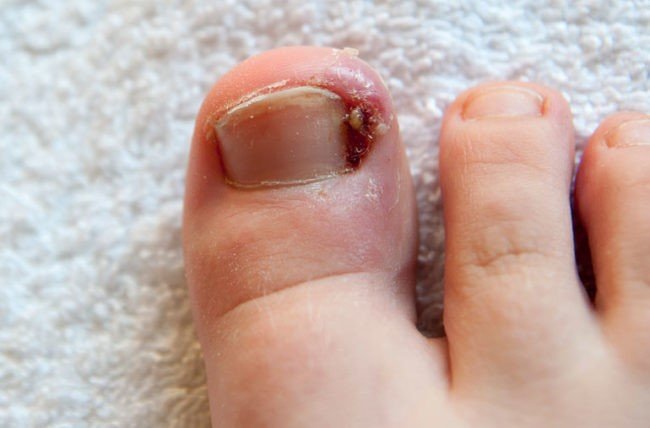Ingrowing Toe Nails
Ingrown Toenail (Onychocryptosis)
An ingrown toenail is a painful toe condition that arises when the toenail's sides or corner burrows into the skin at the toe's end or side. The condition generally affects the big toe's outside edge, although it can also affect the nails on both sides of the toe, or any toe's nail.
What causes toenail ingrowth?
Ingrown toenails can be caused by a variety of factors, but the two most prevalent are ill-fitting shoes and inadequately cut nails.
Shoes that are too tight, have high heels, or have pointed toes squeeze the toes, causing the nail to curl into the flesh and prevent it from growing naturally.
Toenail edges or corners that are not properly trimmed might dig into the flesh. Toenails should be clipped straight across with a straight line at the top.
An ingrown toenail is caused by an injury around the nail, such as a ripped nail or a peeled off edge.
A swollen or enlarged toenail can result from a fungus infection of the nail.
Prescription drugs, especially oral retinoids like isotretinoin and acitretin.
Pincer or trumpet nails are examples of unusual nail shapes.
How can you know if you have an ingrown toenail?
Ingrown toenails are divided into three stages based on their severity.
Stage 1
The toe's end gets reddish and swollen.
It could be heated and uncomfortable to touch.
There is no pus or discharge.
Stage 2
The toe grows more red, swollen, and painful.
Pus or discharge from the region may be white or yellow in colour.
Stage 3
Increased redness, swelling, and discomfort symptoms
Granulation tissue develops and contributes to the swelling and pus discharge.
Hypertrophy of the lateral nail fold (overgrowth of skin tissue around the affected toe)
A more serious infection with a fever may ensue.
How is an ingrown toenail diagnosed?
Ingrown toenails are commonly self-diagnosed based on symptoms and the appearance of the toe.
An ingrown toenail will most likely be diagnosed by your healthcare provider (who could be your normal doctor or a foot expert known as a podiatrist). They'll look at the skin around the nail's edge. Ingrown toenails are diagnosed when the skin is:
Overgrowing the nail
Swelling, tenderness, warmth, and redness.
What is the procedure for treating an ingrown toenail?
Treatment is determined by the stage of the disease. However, the patient should avoid wearing tight-fitting or high-heeled shoes at any stage of an ingrown toenail. Wear sandals if feasible till the weather improves.
The following procedures should be used to treat an ingrown toenail in stage one.
Warm water soaks - soak the foot four times a day in warm water.
Wash your foot twice a day, including the afflicted region, with soap and water.
Gently lift the edge of the nail that is digging into the skin and place a small piece of rolled cotton, gauze, dental tape, or floss between the nail and the skin to keep it elevated.This may be uncomfortable, but it is necessary after each bathing.
Topical or oral antibiotics may be required for a stage 2 ingrown toenail. Topical antibiotic ointments mixed with local anaesthetic agents speed up the healing process while also relieving pain by numbing the affected area. If the situation worsens, surgical excision of the ingrown toenail may be required.
Ingrown toenails in stage 3 are frequently surgically treated. The lateral nail avulsion plus matricectomy surgical procedure has a good success rate. This process is described in more detail below.
A ring block of local anaesthetic is used to numb the injured toe.
The pus will be drained from the toe's end.
To establish a new, straight nail edge, an ingrown toenail is taken out.
To prevent regeneration of the undesirable nail, electrocautery or phenol ablation is utilised to eliminate any cells beneath the area where the nail plate has been taken out.
Any granulation or hypertrophied tissue should be eliminated as well.
The toe is wrapped and antibiotic ointment is applied until it heals fully (usually within a few weeks).
The following procedures should be followed after surgery:
Remove the bandage on the second day and wash the affected area with soap and water.
After surgery, gently dry the region and reapply antibiotic ointment and a new bandage once or twice daily for at least one week.
To ease pain, you can take paracetamol or other analgesics as suggested by your doctor.
Maintain a clean and dry toe. For at least two weeks after surgery, avoid swimming, bathing, or soaking the toe. Showering is permitted.
For the first two weeks after surgery, avoid running, leaping, or any intense activities.
If you notice swelling, redness, or leakage from your toe, contact your doctor.
Ingrown toenail treatment options
A gutter splinter, which uses cut plastic tubing to keep the nail and the lateral nail folds away, can also be used to treat an ingrown toenail. Tape or acrylic adhesive is used to keep these in place. A formable acrylic solution can be used to shape an artificial nail.
Nail avulsion, also known as chemical or medical nail avulsion, is a painless and slow method of removing damaged nails. Ingrown toenails are rarely treated with this method because it destroys the entire nail.
Alternative surgical techniques are outlined, such as removing the soft tissue surrounding the distal phalanx and shortening the bone.
Ingrown toenail treatment options
A gutter splinter, which uses cut plastic tubing to keep the nail and the lateral nail folds away, can also be used to treat an ingrown toenail. Tape or acrylic adhesive is used to keep these in place. A formable acrylic solution can be used to shape an artificial nail.
Nail avulsion, also known as chemical or medical nail avulsion, is a painless and slow method of removing damaged nails. Ingrown toenails are rarely treated with this method because it destroys the entire nail.
Alternative surgical techniques are outlined, such as removing the soft tissue surrounding the distal phalanx and shortening the bone.
What Can I Do to Avoid Ingrown Nails?
The first step in preventing ingrown nails is proper grooming.
To soften your nails, soak your feet first.
Always use nail clippers to cut the nail straight across and leave enough nail to cover the toe to protect it. (Do not use scissors in the corners of the nail since they are difficult to manage.) Using an emery board, smooth sharp edges.
Wear socks and shoes that are the right size. Because they exert pressure on the toes, tight, pointed, high-heeled shoes and tight stockings can create ingrown nails.
Young children's nails should be groomed by their parents. Because of decreased vision and trouble reaching their feet, an older relative may also require assistance.
What Are the Complications of Ingrown Nails?
If you have diabetes, vascular difficulties, or numbness in your toes, you should treat and prevent ingrown toenails with extra caution. Also, don't put off obtaining help. Ingrown nails that are left untreated for a long period can worsen the situation.
Complications that can develop include:
Bone infection
Foot ulcers
Gangrene (decaying tissue). This is rare.
To book for an appointment you can call our normal reception line, 0121 285 5656 or email direct to hello@thepodiatryclinics.co.uk requesting an appointment. Please include your name, date of birth, your address and GP contact details.
You will be sent a form to complete and forward back to us or bring along on the day.




